Invertebrate Anatomy OnLine
Caecidotea and Lirceus
Freshwater Isopods ©
26jun2006
Copyright 2000 by
Richard Fox
Lander University
Preface
This is one of many exercises available from Invertebrate Anatomy OnLine , an Internet laboratory manual for courses in Invertebrate Zoology. Additional exercises can be accessed by clicking on the links to the left. A glossary and chapters on supplies and laboratory techniques are also available. Terminology and phylogeny used in these exercises correspond to usage in the Invertebrate Zoology textbook by Ruppert, Fox, and Barnes (2004). Hyphenated figure callouts refer to figures in the textbook. Callouts that are not hyphenated refer to figures embedded in the exercise. The glossary includes terms from this textbook as well as the laboratory exercises.
Systematics
Arthropoda P, Mandibulata, Crustacea sP, Eucrustacea, Thoracopoda, Phyllopodomorpha, Ostraca, Malacostraca C, Eumalacostraca, Caridoida, Xenommacarida, Nomen nominandum, Neocarida, Peracarida SO, Isopoda O, Asellota sO, Asellidae F (Fig 16-15, 19-67, 19-90)
Arthropoda P
Arthropoda, by far the largest and most diverse animal taxon, includes chelicerates, insects, myriapods, and crustaceans as well as many extinct taxa such as Trilobitomorpha. The segmented body primitively bears a pair of jointed appendages on each segment. The epidermis secretes a complex cuticular exoskeleton which must be molted to permit increase in size. Extant arthropods exhibit regional specialization in the structure and function of segments and appendages but the ancestor probably had similar appendages on all segments. The body is typically divided into a head and trunk, of which the trunk is often further divided into thorax and abdomen.
The gut consists of foregut, midgut, and hindgut and extends the length of the body from anterior mouth to posterior anus. Foregut and hindgut are epidermal invaginations, being derived from the embryonic stomodeum and proctodeum respectively, and are lined by cuticle, as are all epidermal surfaces of arthropods. The midgut is endodermal and is responsible for most enzyme secretion, hydrolysis, and absorption.
The coelom is reduced to small spaces associated with the gonads and kidney. The functional body cavity is a spacious hemocoel divided by a horizontal diaphragm into a dorsal pericardial sinus and a much larger perivisceral sinus. Sometimes there is a small ventral perineural sinus surrounding the ventral nerve cord.
The hemal system includes a dorsal, contractile, tubular, ostiate heart that pumps blood to the hemocoel. Excretory organs vary with taxon and include Malpighian tubules, saccate nephridia, and nephrocytes. Respiratory organs also vary with taxon and include many types of gills, book lungs, and tracheae.
The nervous system consists of a dorsal, anterior brain of two or three pairs of ganglia, circumenteric connectives, and a paired ventral nerve cord with segmental ganglia and segmental peripheral nerves. Various degrees of condensation and cephalization are found in different taxa.
Development is derived with centrolecithal eggs and superficial cleavage. There is frequently a larva although development is direct in many. Juveniles pass through a series of instars separated by molts until reaching the adult size and reproductive condition. At this time molting and growth may cease or continue, depending on taxon.
Mandibulata
Mandibulata is the sister taxon of Chelicerata and in contrast has antennae on the first head segment, mandibles on the third, and maxillae on the fourth. The brain is a syncerebrum with three pairs of ganglia rather than the two of chelicerates. The ancestral mandibulate probably had biramous appendages and a J-shaped gut, posterior-facing mouth, and a ventral food groove. The two highest level mandibulate taxa are Crustacea and Tracheata.
Crustacea sP
Crustacea is the sister taxon of Tracheata and is different in having antennae on the second head segment resulting in a total of 2 pairs, which is unique. The original crustacean appendages were biramous but uniramous limbs are common in derived taxa. The original tagmata were head but this has been replaced by head, thorax, and abdomen or cephalothorax and abdomen in many taxa. Excretion is via one, sometimes two, pairs of saccate nephridia and respiration is accomplished by a wide variety of gills, sometimes by the body surface. The nauplius is the earliest hatching stage and the naupliar eye consists of three or four median ocelli.
Eucrustacea
Eucrustacea includes all Recent crustaceans except the remipedes. The taxon is characterized by a primary tagmosis consisting of heat, thorax, and abdomen although the derived condition of cephalothorax and abdomen is more common. Eight is the maximum number of thoracic segments.
Thoracopoda
In the ancestral thoracopod the thoracic appendages were turgor appendages used for suspension feeding in conjunction with a ventral food groove. Such appendages and feeding persist in several Recent taxa but have been modified in many others.
Phyllopodomorpha
The compound eyes are stalked primitively although derived sessile eyes occur in many taxa.
Malacostraca C
Malacostraca includes most of the large and familiar crustaceans such as crabs, shrimps, lobsters, crayfish, isopods, and amphipods. Primitively the trunk consists of 15 segments, eight in the thorax and seven in the abdomen but in most Recent species the abdomen has only six segments. The female gonopore is on the eighth thoracic segment and the male on the sixth.
Peracarida SO
Peracarida is a large and ecologically important malacostracan taxon. It includes the amphipods and isopods, each with well over 5000 species, as well as several smaller taxa such as mysids, cumaceans, and tanaidaceans. Peracarids have the characteristics of Malacostraca and are further defined by possession of a ventral, thoracic marsupium, or brood pouch, in which the eggs are brooded. The mandible bears a movable tooth, the lacinia mobilis, between the molar and incisor. Development is direct and there is no larva. Most peracarids are small, less than 2 cm and primarily inhabit marine and freshwater habitats, although some are terrestrial.
Isopoda O
Isopoda is a large and diverse taxon with nine high level subtaxa. Isopods are common in marine and freshwater habitats and there are important terrestrial and parasitic suborders. It includes the familiar terrestrial pill bugs, wood lice, and sea slaters, and about 4000 less familiar marine species. Isopods are usually dorsoventrally flattened and the gills and heart are abdominal. One thoracic segment is fused with the head and there is, correspondingly, one pair of maxillipeds and seven pairs of thoracic walking legs. The gills and heart are abdominal.
Asellota sO
Asellota is a large taxon of freshwater and marine isopods. The uropods are terminal and biramous. The posterior four abdominal segments and telson are fused to form the pleotelson. The male, and sometimes female, first pereopods are subchelate. The third pleopods are opercula protecting the remaining pleopods, which are gills. The first pleopods are lost in females.
Laboratory Specimens
Most North American freshwater isopods belong to Asellidae of which there are two important genera, Caecidotea (formerly Asellus) and Lirceus. Asellids are found in surface and subterranean waters with about 30 species reported from North America. Specimens for laboratory use can often be collected from local streams.
The two genera, Lirceus and Caecidotea, are quite similar, in fact they are difficult to tell apart, and this exercise can be used with either. Because of their small size this exercise is limited to external anatomy. The structures described can be found by manipulating a living or preserved specimen with a minuten nadel and fine forceps. The study should be conducted on the stage of a dissecting microscope (10-20X) in an 8-cm culture dish of 5 % ethanol, if living, or tapwater if preserved. Use your judgment in selecting the appropriate magnification and be prepared to change the magnification when necessary.
External Anatomy
Tagmata
Study a male and ovigerous female isopods. Begin with the male and examine it with magnification (Fig 1, 19-62). The basic arthropod tagmata are the head, thorax, and abdomen but most crustaceans, isopods included, have made some adjustments in this basic pattern. Originally the malacostracan head consisted of five segments, the thorax eight, and the abdomen seven. In isopods these have been rearranged into a cephalothorax of six segments, a pereon of seven, and an abdomen of six. Thoracic segments are known as thoracomeres and abdominal segments are pleomeres. Caecidotea is strongly flattened, or dorsoventrally depressed, a characteristic of freshwater isopods and a useful distinction between them and freshwater amphipods, which are laterally compressed.
Cephalothorax
Examine the anterior end of the dorsum of your specimen. In isopods the first thoracic segment is fused with the head to form the cephalothorax, or cephalon, of six segments (Fig 1, 2, 19-62). Superficially the cephalothorax appears to be a single segment but in reality it is six segments and it bears six pairs of appendages. The six segments are fused and cannot be distinguished externally.
In surface-dwelling (epigean) species a pair of small sessile compound eyes is present dorsolaterally on the cephalothorax. These are absent or reduced in hypogean (subterranean) species (Fig 2).
The cephalothorax bears six pairs of appendages belonging to its six segments. Anteriormost is the first antenna composed of a proximal peduncle of three long articles and a shortflagellum of many very short articles (Fig 1, 2).
Next is the second antenna. In asellids the second antenna is much larger than the first. It also is composed of a basal peduncle, but with five articles, and a long, whiplike, multiarticulate flagellum.
The remaining appendages are mouthparts and are all located in an oral cone on the ventral surface of the cephalothorax. Turn your specimen over and find the large cluster of mouthparts under the head. This is the oral cone. The maxillipeds lie on the posterior and ventral surface of the cone and can be seen without dissection (Fig 2, 6). They cover the remaining mouthparts. The maxillipeds are the appendages of the first thoracic segment which, you remember, is fused with the head and its appendages have become accessory mouthparts.
Hidden from view by the maxillipeds are three pairs of true mouthparts belonging to the posterior three head segments. These are the mandibles on the third head segment, the first maxillae on the fourth, and the second maxillae on the fifth and last head segment. The two mandibles lie to the right and left of the mouth on the ventral surface of the head. The maxillae are posterior to the mouth between the mandibles and the maxilliped. Lift the maxilliped with a minuten nadel to see the mouthparts beneath it in the oral cone.
Pereon
The middle region of the isopod body comprises seven segments and is the pereon. The pereon consists of those thoracic segments not fused with the head to form the cephalothorax. These segments, although thoracomeres are known by the more specific name of pereomeres, or pereonites (Fig 2). In the case of isopods and amphipods, only one of the eight thoracomeres is part of the cephalothorax, leaving seven free thoracomeres (pereonites) to form the pereon. These segments are easy to see and count in dorsal view (Fig 1, 2). Look at the dorsum and count the pereonites.
Figure 1. Dorsal view of Caecidotea (Redrawn from Williams (1972). Isopod63L.gif
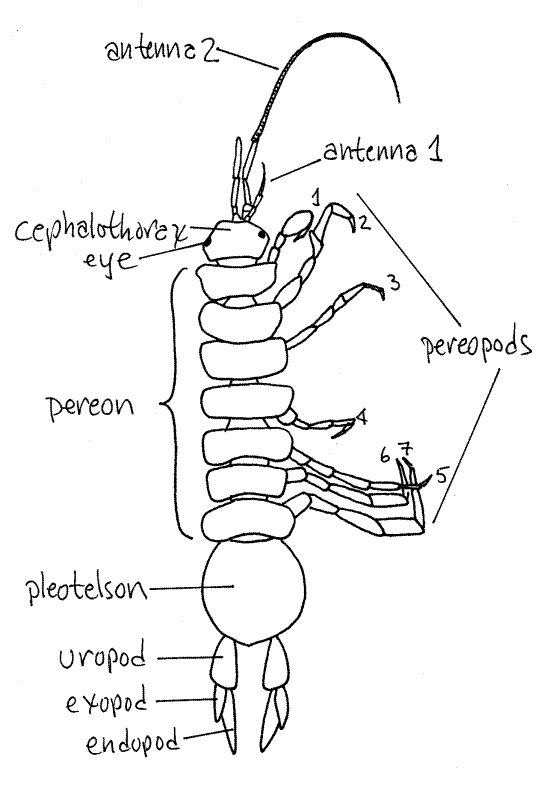
Pereonites are good examples of typical arthropod segments. Each is covered by an exoskeletal ring composed of dorsal and ventral sclerites connected laterally by the flexible articular membranes (Fig 16-1B). The dorsal sclerite is the heavily sclerotized, arched tergite (Fig 1, 2). The seven tergites of the pereon are easy to see and count. The ventral portion of each segmental exoskeletal ring is the sternite (Fig 2). It is also sclerotized but less so than the tergite. The flexible lateral articulations are the pleural membranes.
Figure 2. Lateral view of the subterranean isopod Caecidotea kendeighi (female) (Redrawn from Lewis and Bowman, 1981). Isopod76L.gif
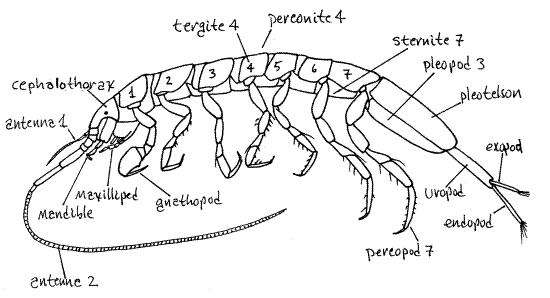
Each tergite is fused laterally with the coxa of its leg. This lateral addition creates an eave overhanging the edge of the segment. Turn your specimen over again and observe that the legs, or pereopods (Fig 2), are attached to the lateral wings of the tergite. Those wings are, in fact, the coxae.
With the exception of the first pair in males, the pereopods are all similar to each other, hence the name "isopod" (= same foot). The first pereopod of males (and sometimes of females) is a prehensile organ known as a gnathopod (Fig 2, 3, 19-62A).
Look at one of the pereopods, whichever one you can see best with higher magnification. Malacostracan thoracic appendages consist of seven articles which are, from proximal to distal, the coxa, basis, ischium, merus, carpus, propodus, and dactyl (Fig 3). Start with the distal dactyl and work your way back to the articulation with the body. You should come up one short. There are only six apparent articles in an isopod leg. This is because the lateral eaves of the tergites mentioned above are, in fact, the coxae which have fused with the tergites so they no longer appear to be part of the limb.
Look more closely at the first male pereopod, the gnathopod (Fig 3). The propodus is enlarged and forms a "palm" against which the dactyl, acting like a finger, closes to form a pincer for grasping. This arrangement is said to be subchelate. The pincers of decapod crustaceans, such as crayfish and crabs, have chelate pincers in which the propodus forms an immovable finger, not a palm, to oppose the dactyl, which is a movable finger. A limb with no prehensile mechanism is said to be simple.
Look at the ventral surface of the pereon. It, like the dorsum, is covered by sclerotized plates but these are sternites. They are flexible and not as heavily sclerotized as the tergites.
Figure 3. The gnathopod (first pereopod) of a male Caecidotea. Redrawn from Williams (1972). Isopod64L.gif
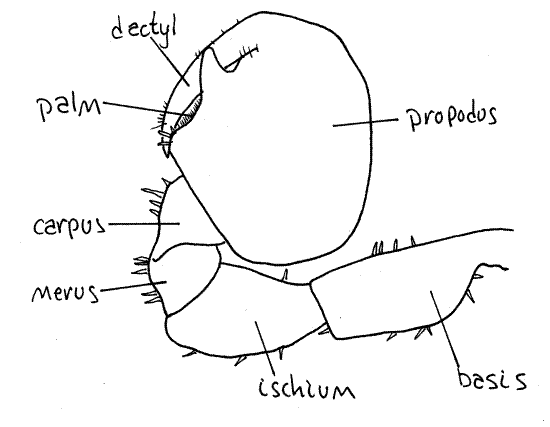
Abdomen
Turn the specimen back over and look at the dorsum of the abdomen, or pleon. Its segments are pleomeres. The first two pleomeres are small and inconspicuous dorsally. The remaining four are fused with each other and with the telson to form a single large pleotelson, in which segmentation is not apparent (Fig 1, 2, 19-62A). The abdominal appendages consist of five anterior pairs of pleopods and a pair of posterior uropods.
Turn the specimen back over and look at the ventral pleon. Five pairs of appendages, known as pleopods, are here but they are not immediately apparent for they do not look like legs and they are stacked under each other. The first two pleopods are small and are highly modified in males. The second pleopods are external genitalia for the transfer of sperm to the female. The fourth and fifth pleopods are gills and the third is an operculum to protect the gills (Fig 6). The gills are located in the branchial chamber under the pleotelson and covered by the opercula.
Figure 4. Anterior pleopods of a male Caecidotea. The endopod of pleopod 2 is the intromittent organ. A, Pleopod 1. B, Pleopod 2. Redrawn from Williams (1972). Isopod65L.gif
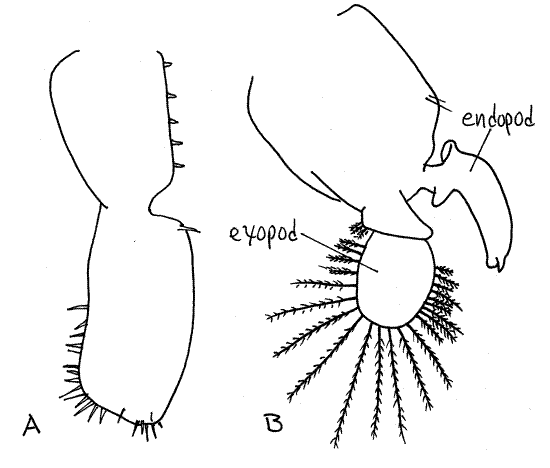
Move the posteriormost pair of pereopods out of the way so you can see the anterior end of the ventral abdomen. This will reveal a pair of tiny digitiform penes (which are not segmental appendages) and pleopods 1 and 2 (Fig 4). The pleopods are folded posteriorly so that the penes lie on top of pleopod 1, which lies on top of pleopod 2, which lies on top of the large operculum (pleopod 3) and so on.
Figure 5. Pleopod 3 of Caecidotea. The exopod is the operculum. The endopod is hidden under the exopod. Redrawn from Williams (1972). Isopod66L.gif
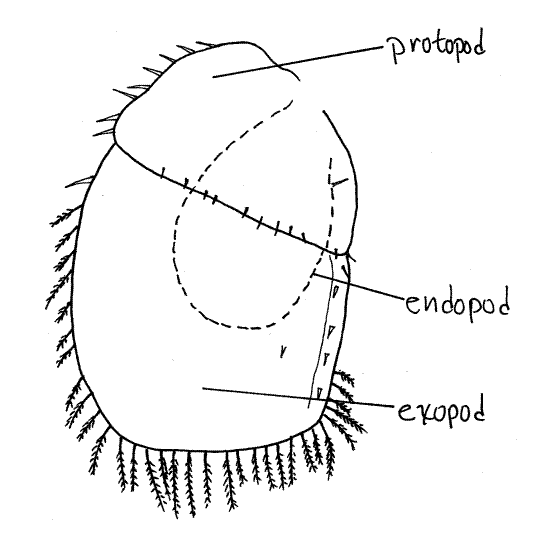
Pleopod 1 is small, two-segmented, and uniramous (Fig 4A). Use the minuten nadel to lift pleopod 1 so you can see pleopod 2. The second pleopod is biramous and its endopod is the intromittent organ (Fig 4B). The tip of this organ is shaped to fit into a seminal receptacle on the female and its shape is species specific. This is a mechanical isolating mechanism. Pleopod 1 is absent in females and pleopod 2 is a small vestige (Fig 6, 19-62B).
Figure 6. Ventral view of an ovigerous female Caecidotea communis. The eggs are indicated under the oostegites. Redrawn from van Name, 1936). Isopod68L.gif
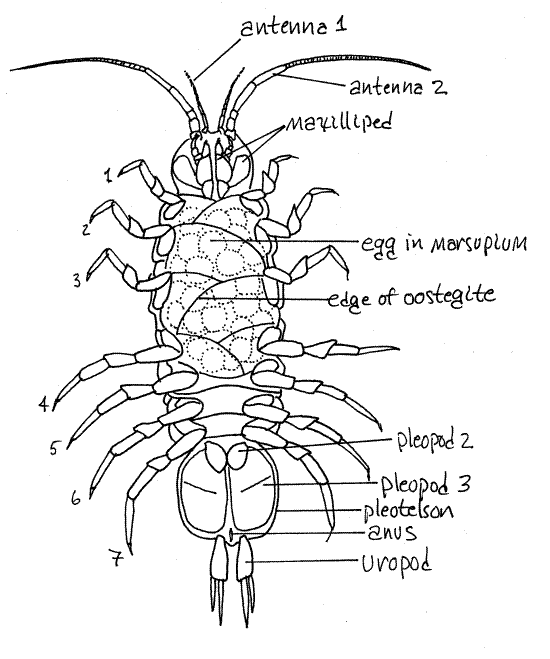
The external genitalia lie atop the two third pleopods. Pleopod 3 is biramous with a large exopod and smaller endopod (Fig 5, 6). The exopods are the large plate-like opercula that protect the remaining two pairs of pleopods. Lift the operculum of and look beneath it. The small endopod is now visible.
Under the operculum are the oval white, page-like endopods and exopods of pleopods 4 and 5. These four rami look like the pages of a book and are the gills. They are housed in the concavity of the ventral pleotelson, a space known as the branchial chamber.
The appendages of the sixth abdominal segment are the biramous uropods which are conspicuous features of the posterior margin of the pleotelson, visible both dorsally and ventrally (Fig 1, 2, 6). Each uropod consists of a basal protopod from which arise two branches, a lateral exopod and a medial endopod (Fig 1, 2). The anus is at the ventral tip of the pleotelson (Fig 6).
Reproductive Female
Examine a female specimen in reproductive condition, with eggs in the marsupium. Place it in a dish of tapwater, if preserved, or, or 5 % ethanol, if alive, and examine it with the dissecting microscope. Review the anatomy you learned on the male specimen and then turn your attention to the ventral pereon.
When reproductive, females develop large thin flexible oostegites, or brood plates, on the medial border of some thoracic appendages (Fig 6, 19-62B, 19-52). These transparent plates overlap each other and enclose a ventral brood pouch, or marsupium, in which the embryos are brooded. Use your minuten nadel to lift the edge of one of the oostegites to demonstrate its presence and construction. They are difficult to see if you don’t lift them. The young may be eggs still or they may be more advanced and recognizable as juvenile isopods. Eggs and embryos are ventilated by movements of the oostegites.
Look at the ventral pereon. The anterior pleopods of males and females differ and in females there are no external genitalia. The first pleopods are absent and the second are vestigial in females (Fig 6) whereas in males the second are intromittent organs. The exopods of the two third pleopods are, as in the male, the opercula for the branchial chamber (Fig 6). The rami of the fourth and fifth pleopods are the gills in the branchial chamber.
References
Couch AP, Thorp JW . 1991. Crustacea: Introduction and Peracarida in Thorp JW, Covich AP (eds). Ecology and classification of North American freshwater invertebrates. Academic Press, San Diego. 911pp.
Lewis JJ, Bowman TE. 1981. The subterranean asellids (Caecidotea) of Illinois (Crustacea: Isopoda: Asellidae). Smithsonian Contr. Zoology 335: 1-66.
Pennak RW. 1989. Freshwater invertebrates of the United States, 3ed. Wiley.
Ruppert EE, Fox RS, Barnes RB. 2004. Invertebrate Zoology, A functional evolutionary approach, 7 th ed. Brooks Cole Thomson, Belmont CA. 963 pp.
Thorp JW. Covich AP. 1991. Ecology and classification of North American freshwater invertebrates. Academic Press, San Diego. 911pp.
Van Name WG. 1936. The American land and fresh-water isopod Crustacea. Bull. American Mus. Nat. Hist. 71:1-535.
Williams WD. 1972. Freshwater isopods (Asellidae) of North America. Biota of freshwater ecosystems Identification manual 7: 1-45. US Environmental Protection Agency, Project 18050 ELD.
Supplies
Dissecting microscope
Living or preserved freshwater isopods, male and female
8-cm culture dish
5 % non-denatured ethanol in lake water